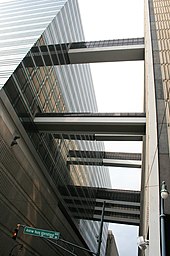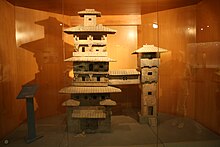
Back طريق علوية Arabic Skyway Danish Gebäudebrücke German Pontopasejo Esperanto Pasadizo elevado Spanish Gaineko igarobide Basque מדרכה עילית HE हवाईपुल Hindi Jembatan layang ID スカイウォーク Japanese


A skyway, skybridge, skywalk, or sky walkway is an elevated type of pedway connecting two or more buildings in an urban area, or connecting elevated points within mountainous recreational zones. Urban skyways very often take the form of enclosed or covered footbridges that protect pedestrians from the weather. Open-top modern skyways in mountains now often have glass bottoms. Sometimes enclosed urban skywalks are made almost totally from glass, including ceilings, walls and floors. Also, some urban skyways function strictly as linear parks designed for walking.
In North America skyways are usually owned by businesses, and are therefore not public spaces (compare with sidewalk). However, in Asia, such as Bangkok's and Hong Kong's skywalks, they are built and owned separately by the city government, connecting between privately run rail stations or other transport with their own footbridges, and run many kilometers. Skyways usually connect on the first few floors above the ground-level floor, though they are sometimes much higher, as in Petronas Towers. The space in the buildings connected by skyways is often devoted to retail business, so areas around the skyway may operate as a shopping mall. Non-commercial areas with closely associated buildings, such as university campuses, can often have skyways and/or tunnels connecting buildings.
The world's largest discontinuous skyway network – Calgary, Alberta, Canada's "+15 Walkway" system – has a total length of 16 km (9.9 mi).[1][2] The Minneapolis Skyway System is the world's largest continuous system and spans 9.5 miles (15.3 km)[3][4] connecting 80 blocks in downtown Minneapolis, Minnesota, United States.
On a smaller scale, terminals of large airports are often connected by skywalk systems, as at Manchester Airport, United Kingdom; in many airports, retractable jet bridges provide a direct connection between airplanes and terminals.
Some cities have the equivalent of a skyway underground, and there are also mixed subway–skyway systems; see underground city.
- ^ "Plus 15 network – Calgary's Skywalk", City of Calgary website, December 19, 2022
- ^ Offin, Sarah (November 30, 2022), "Should Calgary dismantle its Plus 15 skywalk network?", Global News
- ^ "Your Guide to Navigating the Minneapolis Skyway System". Meet Minneapolis. Archived (PDF) from the original on May 22, 2022. Retrieved January 4, 2023.
- ^ Marshall, Lillie (April 15, 2019). "Why See the Minneapolis Skyway and Skyline? – Around the World "L"". www.aroundtheworldl.com. Archived from the original on May 11, 2019. Retrieved January 4, 2023.